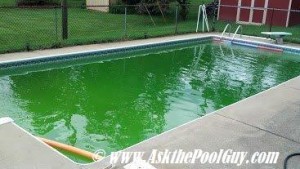 Preventing and killing algae blooms in your pool
Preventing and killing algae blooms in your pool
Algae blooms are essential tiny aquatic creatures that thrive on warms days. There are at least 21,000 types of algae in this words and chances are, some of them have already ended up in your pool. These little guys can turn your pool from sparkling clean to cloudy green overnight.
The good thing about having algae in your pool is that it is a simple fix. They are easily categorized by color and can thus be treated accordingly.
How do Algae Blooms get in my Pool?
They primarily enter your pool through the natural environment: rain, wind, or animals. However, they can also be brought into the pool from swimsuits or even pool equipment. In oder for an algae bloom to form, the conditions have to be just right. The blooms are picky, but not as picky as we’d like. Conditions that algae thrives in are:
- Warmth
- Imbalanced water
- Poor filtration
- Lack of sanitation
- Surplus of sunlight
Algae blooms aren’t exactly harmful to swimmers, but who actually enjoys swimming in a pool full of algae? They can cause other problems besides aesthetic ones. These blooms can harbor bacteria such as E. coli (which can make people really sick). They can clog up your pool filter and damage other pool equipment. It takes effort and dollars to rid your pool of an algae problem and unfortunately, algae eats the chlorine that would typically keep bacteria away.
Four Types of Algae to Look out For
Green:
Green algae is the most commonly seen. After the onset of green algae, the pool owner can expect to find cloudy water that is a result of poor filtration and lack of sanitation. This specific type of algae floats freely in the water and can occasionally form a film across the entire surface of the water. It is known to cling to the pool walls and surfaces.
Yellow:
Yellow algae is an algae that tends to form in the shady spots of your pool. It can cling to the walls or any other pool surface- sometimes forming sheets across the surface of the water in worst-case-scenarios. This variety of algae is extremely difficult to kill; it likes to put up a fight. Because of this fact, re-infection is common. In order to completely clear your pool of yellow algae, you must cleanse it with a high dose of chemicals.
Black:
Black algae is by far the most difficult to get rid of. It forms dark, scary spots on your pool surfaces. Once in a while it can appear as a different color (dark green, purple, or blue). The roots of this algae can bury itself deeply into the plaster or grout of your pool walls and will not go without a fight. In order for black algae to be removed, you have to remove the roots. Some chemicals will remove the top layers, giving the appearance the algae is gone. However, the black algae needs to be removed completely- roots and all.
Pink:
Pink algae is not actually algae but a bacteria that forms spots or streaks in the corner of your pool. It is very slow-spreading.
Find information on the best algaecides on the market in the Pool Guy’s STORE.
